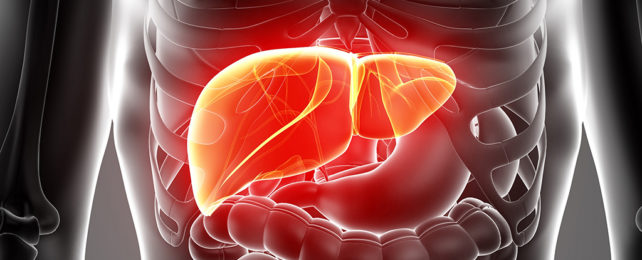Alagille syndrome is a potentially fatal genetic disorder that affects various organs and systems, most notably the liver. At the moment there's no known cure for it – but scientists have now identified a potentially effective treatment.
Called NoRA1, the newly developed drug targets the Notch pathway, a cell-level signaling system in the body that's important for a lot of crucial biological systems, including proper maintenance of the liver.
The genetic mutation behind Alagille syndrome causes a reduction in Notch signaling, which then leads to poor bile duct growth and regeneration, causing bile to build up and damage the liver.
Zebrafish are often used in scientific research into human disease, thanks to our extensive knowledge of its genome, similarities in genes, and ease with which their development can be observed. In the latest piece of research, NoRA1 was shown to boost Notch signaling in zebrafish with similar genetic mutations as those found in children diagnosed with the disease.
Duct cells were triggered to grow and regenerate as healthy liver tissue would, reversing liver damage in the zebrafish. The survival chances of the zebrafish involved in the study were increased by the application of the treatment. In fact, just a single dose of NoRA1 administered four days after fertilization was enough to achieve a threefold improvement in survival rates.
"The liver is well known for its great capacity to regenerate, but this doesn't happen in most children with Alagille syndrome because of compromised Notch signaling," says molecular biologist Chengjian Zhao, from the Sanford Burnham Prebys Medical Discovery Institute in California.
"Our research suggests that nudging the Notch pathway up with a drug could be enough to restore the liver's normal regenerative potential."
One of the benefits of the drug is that it targets processes in the body that should be happening naturally. That bodes well when it comes to testing this out in actual people further down the line, should the therapy progress to clinical trials.
"Instead of forcing the cells to do something unusual, we are just encouraging a natural regenerative process to occur, so I'm optimistic that this will be an effective therapeutic for Alagille syndrome," says molecular biologist Duc Dong, also from the Sanford Burnham Prebys Medical Discovery Institute.
There's scope for NoRA1 to help with other common diseases too, so important is the Notch pathway to the proper functioning of everyday biological processes. For now though the focus is on how it can help with this rare liver disease.
More than 4,000 babies a year are born with Alagille syndrome, and liver transplants are often needed. Without a transplant – and donors are in short supply – there's a 75 percent mortality rate by late adolescence.
At the moment, the researchers are working on miniature livers grown in the lab, using stem cells derived from patients with Alagille syndrome to test the NoRA1 drug further. There's still a long way to go, but the signs are promising.
"Alagille syndrome is widely considered an incurable disease, but we believe we're on the way to changing that," says Dong.
"We aim to advance this drug into clinical trials, and our results demonstrate its effectiveness for the first time."
The research has been published in PNAS.
